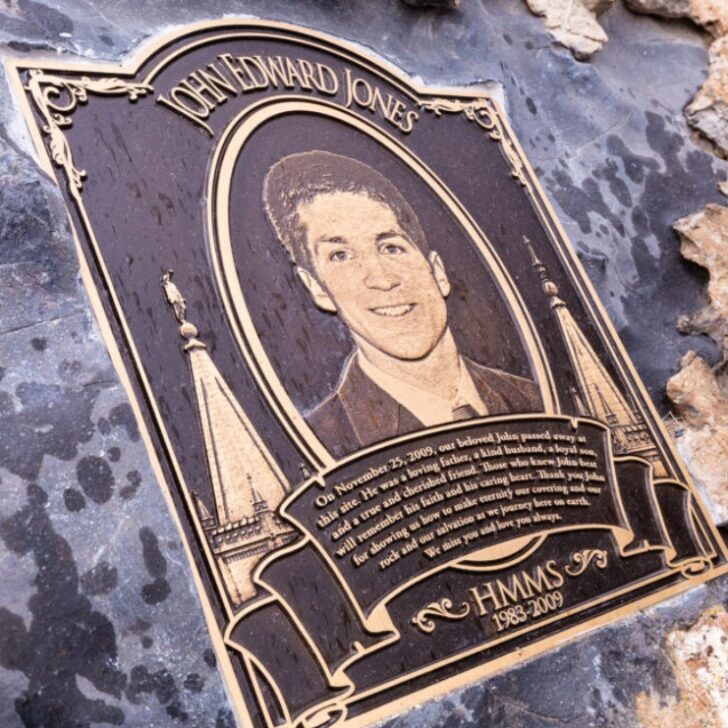Joseph Merrick walking the streets of Victorian Leicester, England, was a frightening sight. His enlarged head and deformed body were so twisted and unusual that people would cross the street to avoid making eye contact with him.
Those two sentences sound like the opening to a fictional horror story, but they’re not. While it may be hard to believe, the story of Joseph Merrick, the Elephant Man, is a true one.


Who Was Joseph Merrick?
Joseph Merrick was born to an impoverished working-class family in August of 1862. He was a perfectly normal child at birth and for a few short years after.
But normality didn’t last long for Joseph Merrick. By the age of five, his body had begun to betray him, and as he reached his late teenage years, he had become almost unrecognisable as a human being.
As Merrick grew up, he developed a catalogue of unusual symptoms that had never been seen by doctors or surgeons of the era.
The initial appearance of tumours on his back might not have been too concerning, but they were to be rapidly followed by unnatural bone growth on his forehead, feet and right hand.
As he aged, Merrick’s skin also underwent a significant change. It turned as grey and wrinkled as that of an elephant. Over time, the tumours multiplied and spread to other parts of his body, and he became increasingly disfigured.
To add to his already substantial suffering, Merrick was plagued by enormous warts that oozed a foul-smelling secretion.
Bad health wasn’t the only cruel twist of fate that Merrick had to endure during his lifetime. Up until the age of eleven, Merrick led a relatively normal home life.
He was cared for by his mother in a family-oriented environment and went to school along with his siblings. After the premature death of his mother, that all changed, and from twelve onwards, his life can only be described as Dickensian.
How Joseph Merrick Became The Elephant Man
Soon after the demise of his mother, Merrick’s father remarried, and it was Merrick’s new stepmother who would turn his already troubled existence into a true living nightmare.
Regardless of his physical disabilities, his stepmother forced Merrick to go to work to earn his keep.
For two years, Merrick managed to hold down a position rolling cigars for a company called Freeman’s Cigar Manufacturers.
But when the increased disfigurement of his right hand meant he could no longer manipulate the tobacco leaves, he found himself unemployed and once again in dire straits.
Merrick’s stepmother was a woman of little empathy, and even though his disfigurement was by then well-advanced, she still insisted he went out to work.
Unable to find anyone willing to give him a job, Merrick’s father obtained him a street sales licence and sent him out to peddle goods from house to house. Because of his appearance, he was unsuccessful as a door-to-door salesman.
Without an income, Merrick’s stepmother would not let him stay in her home. At the age of seventeen, with nowhere to live and unable to support himself, Merrick’s only option was the workhouse, which is where he stayed for five years.
Little is known about the years Merrick spent in the Leicester Union workhouse or why he took it upon himself to make contact with the travelling showman, Samuel Torr, who had retired to the city.
When Torr visited Merrick, he soon saw his potential as a circus sideshow attraction.
Along with Torr’s business partners, who created the name Elephant Man to promote him, Merrick was toured around the county as a freak.
Uncannily, while Merrick’s horrific appearance ostracised him from being a part of normal society, his deformities were something the Victorian working classes were happy to pay to get a closer look at.
Merrick was a success as a freak show attraction, and so he earned relatively decent money from exhibiting himself.

Torr eventually handed his management over to Londoner Tom Norman. Norman was a human oddities exhibition specialist who ran a small theatre in the city’s back streets.
It was at that theatre that Merrick first met the surgeon who would eventually allow him to live out the rest of his life in relative comfort, but who would first get the theatre where Merrick worked closed down.
The surgeon in question was Frederick Treves, who took a professional interest in Merrick’s unusual condition.
After being examined by Treves and his fellow surgeons and finding himself without employment again, Merrick decided to join a circus touring Europe.
Bad luck followed Merrick to the continent, where he was robbed by the circus manager and left to his own devices to find a way to return to England.
How Did The Elephant Man Pass Away?
Once Merrick arrived back in London, with no resources and nowhere else to go, he approached one of the few people who had been kind to him for help.
That person was the surgeon, Frederick Treves. Treves was horrified at the state of Merrick’s health and had him admitted to the Royal London Hospital as a patient.
After managing to stabilise Merrick’s health issues, which by then also included a serious heart problem, Treves began to search for somewhere Merrick could stay long-term but was unsuccessful.
Another of Merrick’s supporters, Carr Gomm, wrote to The Times newspaper outlining Merrick’s story and asking for suggestions on how he could be helped further.
Donations received after the letter’s publication meant the hospital was able to finance Merrick’s stay on a permanent basis.
Merrick lived out the rest of his life in specially converted rooms at the hospital, where he passed away from a broken neck at the age of twenty-seven.
What Disease Did The Elephant Man Have?
When Joseph Merrick first began to develop signs of the disease that would set him apart from the rest of the population of Victorian England, nobody had any idea of what he was suffering from.
]It was thought by many that his condition was the result of his mother being trampled by a circus elephant during her pregnancy.
Merrick himself thought this and mentioned the incident in a short autobiography he wrote while working as an oddity exhibit in Norman’s London theatre. That wasn’t the case, though.
As medical knowledge grew, his deformities were likened to those suffered by people with a tropical disease known as elephantiasis.
Elephantiasis, lymphatic filariasis, causes a similar deformity of the limbs to those that Merrick had, as well as thickening of the skin. At the age Merrick began to show the symptoms that would haunt him for the rest of his life.
But he had never been out of England, so he could not have been infected by the parasite that causes elephantiasis.
While many leading names in the medical field examined Merrick during his lifetime, they were unable to provide a concrete diagnosis for his condition. They also couldn’t find a cure or prevent the progression of the disease.
By the time Merrick had reached the age of twenty-seven, he was bedridden as the weight of his head had become too much for his small frame to support. One night, after making a wrong move in the bed, he passed away in his sleep.
Curiosity about Merrick’s medical condition didn’t disappear with his death. Since his passing in 1890 many have tried to fathom what it was that afflicted him.
It wasn’t until 1986 after DNA research was conducted by Canadian geneticists on scrapings from Merrick’s skeleton, that a reasonable diagnosis was found.
While still not 100% conclusive, those tests showed that Merrick may have suffered from an extremely rare genetic disorder called Proteus Syndrome.
Proteus Syndrome is a very rare condition that’s suffered by around one person in every million. Joseph Merrick, the Elephant Man, was, sadly for him, that one in a million.
Even if he was born today, it’s unlikely Merrick would live much longer than he did, as there is no cure or treatment for the syndrome.
As he was in life, he is in death, and Merrick continues to be an object of speculation as well as an exhibit as his skeleton is on display at the Royal London Hospital, where he spent the last few years of his life.
Sources
https://www.bbc.com/news/uk-england-leicestershire-48149855
https://www.ncbi.nlm.nih.gov/pmc/articles/PMC3036577/
https://publicdomainreview.org/pd-texts/the-autobiography-of-joseph-carey-merrick-1884/













Leave a comment